Starting the E-commerce Journey with Online Store Design

#Online_Store_Design is the first and crucial step to entering the dynamic world of e-commerce.
This process is not limited to just building a website, but includes precise market analysis, understanding target audiences, and strategic planning to provide an unparalleled user experience.
A successful e-commerce website design provides a powerful platform for showcasing products, attracting new customers, and increasing sales.
This educational section introduces you to the initial concepts and importance of this fundamental step.
From choosing the right domain and reliable hosting to understanding the importance of loading speed and website responsiveness, all are key details that must be considered.
An efficient online store is your business’s digital storefront, available to customers 24 hours a day, seven days a week.
Therefore, investing in professional web design is not just an additional cost, but a profitable investment for the future of your business.
Meanwhile, choosing the right platform such as WooCommerce, Shopify, or PrestaShop plays a significant role in the project’s success.
Are you bothered by losing customers who visited your site to buy?
Rasaweb is your specialized solution for having a successful online store.
✅ Significant increase in your online sales
✅ Building trust and professional branding with customers⚡ Get free consultation from Rasaweb experts!
Choosing the Right Platform for Your Online Store
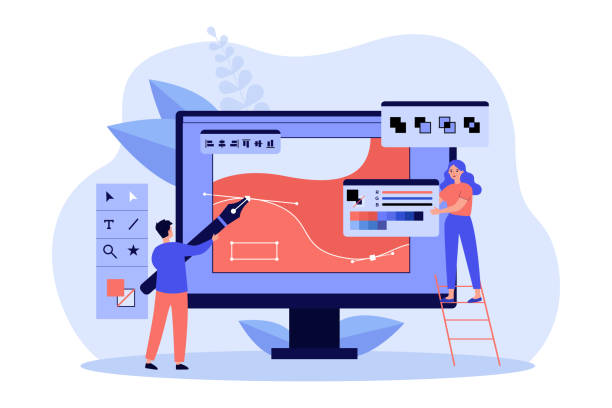
A question many business owners face is: which is the best platform for e-commerce website design? This is a thought-provoking question whose answer depends on your needs, budget, and long-term goals.
Are you looking for high flexibility of open-source coding or do you prefer the simplicity and support of a ready-made platform (SaaS)? Each option has its own advantages and disadvantages.
Open-source platforms like WordPress WooCommerce or PrestaShop offer infinite customization possibilities but require more technical knowledge for setup and maintenance.
In contrast, SaaS platforms like Shopify, by providing integrated solutions and cloud hosting, make the process of creating an online store much simpler for non-technical users, but may have customization limitations.
Making a decision at this stage is crucial, as changing platforms in the future can be time-consuming and costly.
Therefore, comprehensive research and consultation with business website design specialists are highly recommended for choosing the best path.
The Importance of User Experience (UX) and User Interface (UI) in E-commerce Website Design
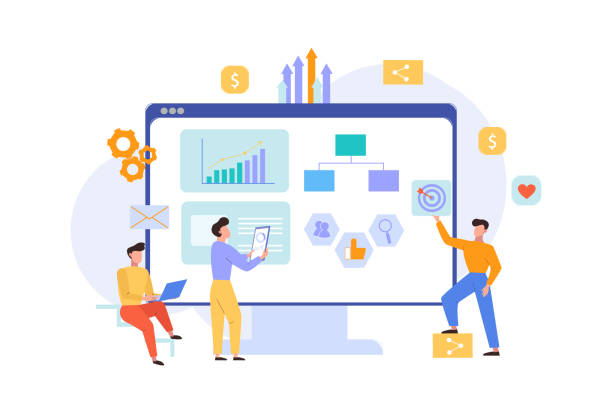
In today’s competitive world, User Experience (UX) and User Interface (UI) play a vital role in e-commerce website design.
A beautiful but difficult-to-use site quickly drives customers away.
In contrast, a delightful user experience and an intuitive, attractive user interface not only encourage users to stay and explore more but also significantly increase conversion rates.
This specialized section examines the details of implementing effective UX/UI.
Responsive Design, which displays your website well on any device, high loading speed, simple and logical navigation, an easy and few-step purchasing process, and robust search capabilities are all key factors in improving UX/UI.
Additionally, using appropriate color schemes, readable fonts, and high-quality images greatly contributes to the site’s visual appeal.
The ultimate goal is for users to access their desired products without any obstacles and complete the purchase process with minimal effort.
This approach leads to increased customer satisfaction and loyalty.
Table 1: Comparison of Popular E-commerce Website Design Platforms
| Feature | WordPress WooCommerce | Shopify | PrestaShop |
|---|---|---|---|
| Platform Type | Open Source | SaaS (Software as a Service) | Open Source |
| Flexibility Level | High (requires development) | Medium (with apps) | High (requires development) |
| Ease of Use | Medium (requires technical knowledge) | High | Medium |
| Initial Cost | Low (hosting and domain) | Monthly Subscription | Low (hosting and domain) |
| Expandability | High (plugins and themes) | Medium (apps) | High (modules and templates) |
| Technical Support | User community and developers | Dedicated support team | User community and developers |
Latest Developments in E-commerce Website Security

As cyberattacks become increasingly sophisticated, e-commerce website security has become one of the most significant concerns.
This is a news and up-to-date section that helps you stay informed about the latest security protocols and techniques in e-commerce website design.
From SSL/TLS certificates for encrypting sensitive customer information to the use of powerful firewalls (WAF) and intrusion detection systems (IDS/IPS), all are essential for data protection and maintaining customer trust.
Reports indicate that many successful attacks occur due to irregular updates of systems and software.
Therefore, a strong security strategy, including regular patching of vulnerabilities, continuous data backup, and employee training to identify phishing and social engineering attacks, is of paramount importance.
Additionally, compliance with security standards such as PCI DSS is mandatory for sites that process credit card information.
Investing in security not only protects your business’s reputation but also prevents financial and legal damages resulting from data breaches.
Disappointed with your e-commerce site’s low conversion rate? Rasaweb transforms your online store into a powerful tool for attracting and converting customers!
✅ Significant increase in visitor-to-buyer conversion rate
✅ Unparalleled user experience to boost customer satisfaction and loyalty⚡ Get free consultation from Rasaweb!
How to Incorporate SEO into Your E-commerce Website Design?
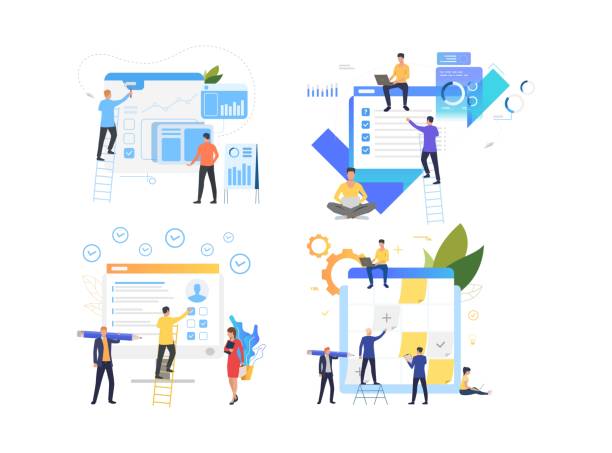
SEO (Search Engine Optimization) is one of the most important factors for the success of any website, especially in e-commerce website design.
Without SEO, even the most beautiful and user-friendly site might go unnoticed among a multitude of competitors.
This explanatory section shows you how to natively implement SEO from the very initial stages of online store platform design.
From selecting appropriate keywords for products and categories to optimizing images, page loading speed, and URL structures, all of these impact your site’s ranking in search results.
High-quality and unique content for product descriptions and blog articles plays a significant role in attracting organic traffic.
Creating logical internal links and acquiring backlinks from reputable sites are also important off-page SEO strategies.
Remember that SEO is a continuous process and requires monitoring and updating to maintain your position in search engines.
Step-by-Step Guide to E-commerce Website Design from Idea to Launch

Are you ready to turn your idea into a reality? This section provides a step-by-step guide for e-commerce website design from beginning to end.
First, you need to conduct thorough market research and define your product or service.
Next, it’s time to choose a domain name and hosting, which should be reliable and fast.
The next step is selecting the right platform, as mentioned earlier.
After that, we move on to the visual design of the site; choosing a template, color scheme, and fonts that align with your brand identity.
In the next stage, it’s time to add products.
This section includes uploading high-quality images, writing accurate and engaging product descriptions, and setting prices.
Setting up secure and diverse payment gateways is also highly important so that customers can easily complete their purchases.
Finally, before the official launch, thoroughly testing the website to ensure all sections function correctly is essential.
This guide helps you enter the market with a professional and functional business website.
Success Stories in the World of E-commerce Websites
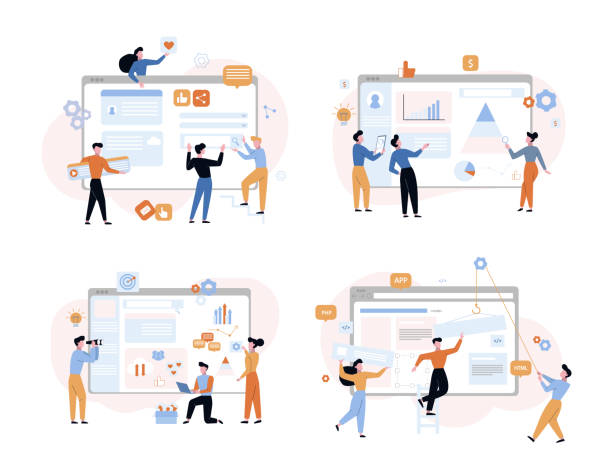
What could be more inspiring than real success stories? This entertaining yet educational section examines examples of businesses that have achieved significant success through smart e-commerce website design and creative marketing strategies.
From small startups that began with a unique product to large brands that have strengthened their online presence, each has valuable lessons for us.
These stories show how focusing on customer experience, innovating in product and service offerings, and effectively utilizing digital marketing tools can elevate an online store to its peak.
This section encourages you to seek your unique strength and value proposition instead of mere imitation.
These stories also emphasize the importance of data analysis and continuous improvement; as the world of e-commerce is constantly changing, and only those who adapt to these changes succeed.
Table 2: Key Steps in the E-commerce Website Design Process
| Step | Description | Importance |
|---|---|---|
| 1. Planning and Research |
Understanding the market, competitors, target audience, setting goals and budget. | Foundation for success and preventing rework. |
| 2. Platform and Hosting Selection |
Deciding on the platform (WooCommerce, Shopify, etc.) and choosing a hosting service. | Technical foundation and website performance speed. |
| 3. UX/UI and Graphics Design |
Visual design, user experience, navigation structure, and user interface. | Attracting and retaining customers, increasing conversion rates. |
| 4. Development and Implementation |
Coding, plugin installation, system configuration, and payment gateways. | Correct functionality and website capabilities. |
| 5. Content and Product Import |
Uploading images, product descriptions, pricing, and other textual content. | Providing complete and engaging information to customers. |
| 6. SEO and Optimization |
Optimization for search engines, site speed, and performance. | Increasing visits and visibility in search results. |
| 7. Testing and Launch |
Thorough review of all sections, bug fixing, and final publication. | Ensuring flawless operation before public access. |
| 8. Marketing and Analysis |
Advertising, data analysis, continuous improvement, and site development. | Business growth and maintaining competitiveness. |
Digital Marketing After E-commerce Website Design
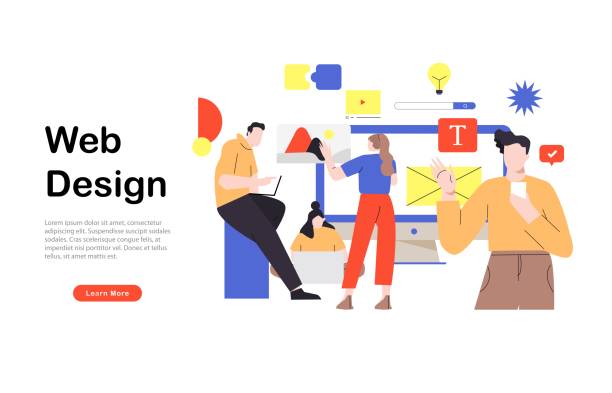
After completing your e-commerce website design, your work has just begun! Digital marketing plays a vital role in attracting customers and increasing sales.
This section provides a comprehensive guide on digital marketing strategies after launching your shopping site.
From content marketing and creating a blog to attract organic traffic, to advertising campaigns on social networks and Google Ads, each is a powerful tool for reaching your target audience.
Email marketing is also very effective for informing loyal customers and encouraging them to make repeat purchases.
Collaborating with influencers and running contests and discounts can also help increase brand awareness and attract new customers.
It’s important to tailor your marketing strategy based on a deep understanding of customers and data analysis.
The ultimate goal is to direct targeted traffic to your site and convert this traffic into paying customers.
Are you bothered by losing customers due to your e-commerce site’s outdated appearance or slow speed? Rasaweb’s expert team solves these problems with professional e-commerce website design!
✅ Increased customer trust and brand credibility
✅ Stunning speed and excellent user experience
Get a free consultation with Rasaweb right now ⚡
The Future of E-commerce and Online Store Design

The world of e-commerce is constantly evolving, and anticipating future trends is vital for any business.
This analytical section examines emerging trends in e-commerce website design and the future of e-commerce.
From artificial intelligence and machine learning for personalizing customer shopping experiences to augmented reality (AR) and virtual reality (VR) for providing more immersive product experiences, new technologies are transforming the face of online stores.
Additionally, increased use of Voice Commerce, and the growing importance of sustainability and social responsibility in customers’ purchasing decisions, are other important trends.
Future e-commerce websites are expected to increasingly become omnichannel platforms that offer a seamless shopping experience across all touchpoints (website, mobile application, social networks, physical stores).
To succeed in the future, businesses must pay attention to these trends and integrate these technologies into their e-commerce platform development.
Challenges and Solutions in E-commerce Website Design
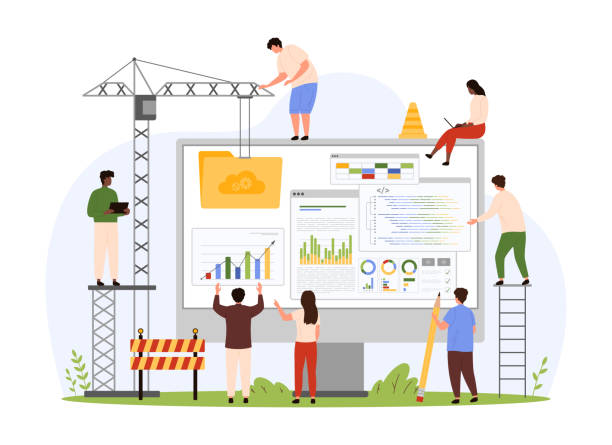
Every e-commerce website design project comes with its own specific challenges.
This explanatory and analytical section explores some of the most common challenges and provides practical solutions to overcome them.
From intense competition in the online market and attracting quality traffic to complex inventory and logistics management, and maintaining security against cyber threats, each requires a strategic approach.
One of the main challenges is the high cart abandonment rate, which can be reduced by optimizing the checkout process, offering diverse and transparent shipping options, and building trust through customer reviews and security certificates.
Another challenge is the need for continuous updates and adaptation to changes in technology and consumer behavior.
The solution is to have a strong support team and regularly monitor and optimize your site’s performance.
By understanding these challenges and planning correctly, you can put your e-commerce website on the path to success.
Frequently Asked Questions
| Question | Answer |
|---|---|
| What is e-commerce website design? | The process of creating an online platform for displaying, selling, and managing products or services to customers on the internet. |
| Why are UI (User Interface) and UX (User Experience) design important for an e-commerce website? | Good UI/UX design allows users to easily navigate the site, find their desired product, and complete the purchase process without difficulty, which leads to increased sales and customer satisfaction. |
| What features should be included in a professional e-commerce website? | Comprehensive product catalog, user-friendly shopping cart, product comparison feature, robust filtering and search system, secure payment gateway, user panel, customer review section, and mobile optimization. |
| Which platforms are commonly used for e-commerce website design? | Ready-made platforms such as WooCommerce (on WordPress), Shopify, Magento, as well as custom development depending on project needs and budget. |
| What are the most important security tips in e-commerce website design? | Using HTTPS (SSL) protocol, payment gateway security, protection against common attacks (like SQL Injection, XSS), and regular updates of the platform and plugins. |
And other services of Rasaweb Advertising Agency in the field of advertising
Smart Direct Marketing: Transform user engagement with SEO-driven content strategy.
Smart Content Strategy: Professional optimization for customer behavior analysis using user experience customization.
Smart Website Development: Designed for businesses seeking to increase sales through key page optimization.
Smart Marketplace: A new service for increasing online growth through the use of real data.
Smart Custom Software: Professional optimization for customer behavior analysis using attractive user interface design.
And over hundreds of other services in the field of internet advertising, advertising consultation, and organizational solutions
Internet Advertising | Advertising Strategy | Advertorials
Sources
Successful E-commerce Website Design – Namadpich
E-commerce Website Design Guide – Rayvarz
How to Have a Successful Online Store? – Modiran
E-commerce Website Design Services – Webramz
? Ready to revolutionize your business in the digital world? Rasaweb Afarin Digital Marketing Agency paves your path to success by providing comprehensive services including custom website design, SEO, and online advertising.
📍 Tehran, Mirdamad Street, next to the Central Bank, South Kazeroon Alley, Ramin Alley, No. 6
